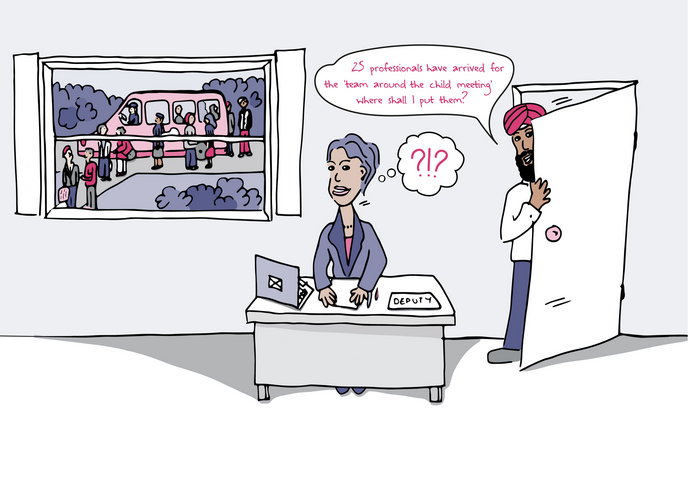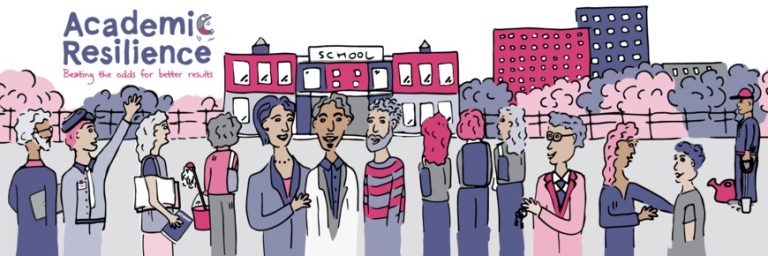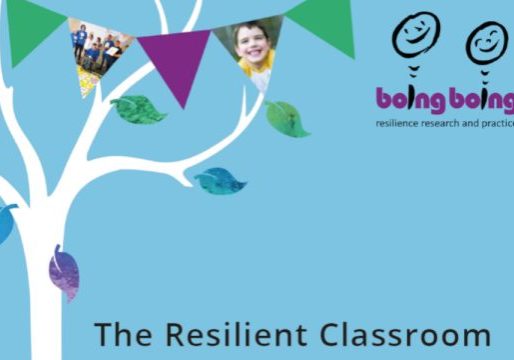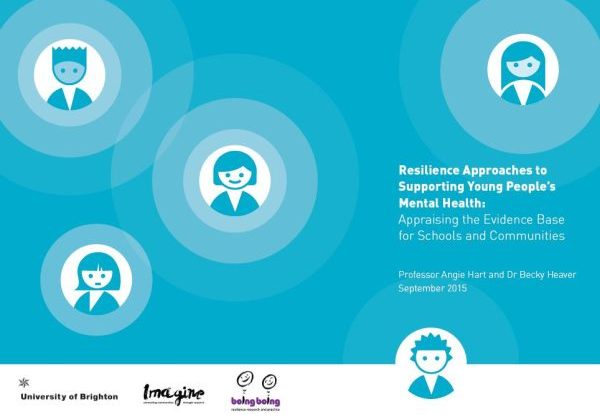Schools key points
• Focusing on just a few quick and easy activities can have an impact
• A whole schools approach makes a bigger difference – get the whole school community involved
• For specific ideas and activities, use the menu below
Where to start
Well, you can start by focusing on just a few things, apart from Quality First Teaching of course, which you’ll know all about.
Get these few things going, or if you’ve already have, make sure you are doing them well and sharing them with the whole community.
Evidence and practice based experience tells us there are a few key actions that you could take in school that would have impact. (There are others of course and you might want to have a look at the Resilience Framework for even more detail on the kinds of things you can do but here we have picked out the strongest themes from the evidence base for schools).
Quick wins
The Resilient Classroom: Want a resource so you can get on with promoting resilience in PSHE or tutor group? Try our Resilient Classroom resource for bite size, downloadable activities for 20 min sessions.
Haven’t got time for reading?
Watch our film made with young people talking about their school days and what you could do to make school life better for disadvantaged pupils.

Want to find out what other people have done? Try our short films or check out the schools that won the Children and Young People’s Mental Health Coalition’s Resilience in Schools competition.
Are you using the Academic Resilience Approach in your school?
Have you been using the Academic Resilience Approach? We’re really keen to hear from people using the ARA in their schools, or even just some of the ideas and tools.
Evidence
In the late 1970s Michael Rutter, a psychiatrist who specialises in resilience wrote a book with some colleagues, Fifteen Thousand Hours. It was about the effect of secondary school education on pupils.
That’s a lot of hours and if you add the number of hours pupils spend in primary schools to this figure, you are talking about what equates to major opportunities to influence pupils and what kind of lives they will end up leading.
So the importance of schools in developing resilience cannot be overstated. Resilience researchers have, through numerous studies, been reiterating and evidencing this quite obvious fact for many years.
Let’s just quote one of the most well-known of these researchers. Anne Masten and colleagues (Masten, Herbers, Cutuli & Lafavor (2008 p1) say:
“Effective schools and teachers provide children on a daily basis with mastery experiences, opportunities to experience success and enjoy achievement that also serve to foster intrinsic motivation, self-efficacy, and persistence in the face of failure.”
Get as many adults from the schools staff and volunteering community (including cooks, cleaners, administrative staff, teachers, TAs etc.) together in one room for half a day and do our Resilience Zap with them. This gives a great introduction and can be either the start of a programme in school or simply a one-off activity.
How?
You can follow the step-by-step guide that shows you how to structure the day and what to cover.
Why?
Because building resilience is everyone’s business. It’s important to have everyone in schools aware of what they can do, how they can work together, and what they are already doing to build pupils’ resilience.
So the more awareness you can build in your staff and volunteers, the greater the effects. Small changes really do have big effects for vulnerable pupils, and if you get a resilient move (a resilient move is any single action that someone in the school community takes to support pupils’ resilience building) going in one part of the school, this can have knock-on effects elsewhere.
One headteacher involved in putting together our approach uses a famous quote from NASA to illustrate this idea.
“The folk tale goes like this, one day a visitor came to the space station and asked a cleaner who was sweeping up what job they did there. The cleaner replied ‘I help put men on the moon.”
Imagine what it would be like in your school if every adult in the school community’s answer to a visitor asking what they do was ‘I help our most vulnerable pupils achieve better than any of us could ever have imagined they would’.
Help pupils to understand what resilience is about and how they can apply it in their own lives
Part of this concerns raising aspirations for pupils who face the most challenges and helping them to see that they can achieve against the odds.
It can also help more advantaged pupils understand and appreciate just how lucky they are. It can ensure that all pupils in school have been given the opportunity to understand and do something to challenge the effects of social inequalities on educational attainment and life achievements for the most vulnerable young people.
How?
School assemblies are a good starting point.
• Try our assembly guide and tips for giving an assembly on resilience using stories from staff
• The Tutor Pack (Resilient Classroom) (pdf) also has ideas on how to do this in class. It has over 50 classroom activities covering every aspect of resilience and all in bite size sessions – perfect for schools to use in class or tutor time. Check out how it is being used at Hove Park School in Brighton

If you are a teacher, you will know that resilience fits naturally in to many different curriculum areas. And conversations about resilience should include conversations about how our society may need changing in some ways, rather than just working individually with pupils on their own resilience.
For KS4 and KS5 how about stimulating debate around inequalities and resilience? The Equality Trust have lots of material to help you with this (you are probably already doing some of this).
For younger pupils, the majority of the activities in the Resilient Classroom resource pack are suitable for KS1 or can be easily adapted.
Why?
Helping pupils understand what resilience is and how it can be achieved will support them to take ownership of the processes involved. It may also help more advantaged pupils to achieve social justice for more challenged pupils in their schools and beyond.
There are simply piles of evidence showing us that unequal societies are pretty rubbish for everyone in them. The biggest resilient move anyone could make is to even up some of the big injustices in society (like massive pay differentials).
Mental health problems, teenage pregnancy and poor maths and literacy levels are just some of the problems which loom large in unequal societies. Getting the whole school community excited about understanding the problem and doing something about it might give us hope for a fairer future. It’s all part of closing the gap between the advantaged and disadvantaged – and their academic progress.
Ensure that vulnerable pupils have at least one supportive adult they can turn to in the school community
For some pupils this will just be a case of identifying someone already working with them, it could be a learning mentor, a teacher, or Head of Year.
The key is to find someone who has a positive relationship with that pupil, perhaps where there is some good rapport, and to encourage and support that adult to stick with them.

Try not to keep changing that person. They need to develop a supportive relationship with someone over time.
Staff and volunteers also need to be given the authority to communicate to pupils that they do actually care about what happens to them. Hear how powerful that was for Lionel, now working at Eleanor Smith Special School in Newham.

What adults say and do is noticed by pupils who face problems and can be hugely significant – it can also be misinterpreted.
A good exercise is to get together a group of vulnerable pupils and talk to them about support in the school community. We have done this with pupils with challenging behaviour for example and some pretty powerful and often surprising stuff comes up. It’s good learning for the school.
But don’t make the mistake of always putting pupils with challenging behaviour together. It’s really useful for them to have individual time with good adult mentors, and be kept away from each other, all easier said than done, we know.
Some Heads we have spoken to made structural or staff changes in order to support relationship building in the schools, such as employing learning mentors or TAs specifically to support vulnerable or disadvantaged pupils or re-structuring so that a tutor goes through school with one group of pupils and develops rapport and relationships with those pupils.
Why?
Of all the strategies to help vulnerable pupils manage life better, this has the potential to make the biggest difference.
When looking back to their childhood, people who have achieved against the odds can often identify one significant adult who made the difference, someone who believed in them, was there for them over time, didn’t judge them and didn’t give up.
A supportive adult that you know is there for you and cares what happens to you can be an anchor in school for many vulnerable pupils. It will help them stay more settled in school and can provide them with a sense of stability and security. This has a knock-on effect on learning.
Help with the basics for those pupils who really need it
How?
Schools come up with all kinds of ingenious and resilient moves to help pupils who, for whatever reason, are not getting their basic needs met, like food, clothing, transport, even housing.
Thresholds for children’s services are relatively high and schools are increasingly moving in to the gap or buying in their own helping services.
Of course there is the Pupil Premium which your school will be getting so have a think about what that’s being used for. Some of that could, and probably is already, being spent on the basics.

In school this can mean activities such as breakfast clubs, taking pupils to health appointments when no-one else will get them there, washing uniforms and other pretty basic support. This can help level the playing field for some students – just as we try to for SEND pupils in learning support. Check out the level of support some schools offer in this short film about Sir John Thursby Community College in Burnley.

As the Head David Burton says,
“For some children the barriers to achievement are higher than for others, a hungry, cold, ill, malnourished, neglected child would be incredibly resilient if academic achievement were their first priority! We want to ensure all of the basic barriers are removed.”
Why?
We have heard tons of stories about poor diet, lack of sleep, unwashed clothes, chaotic homes and much worse (and no we’re not just talking about the staff!). And if we had a pound for every time a wise Head has said to us ‘How can my pupils learn if they are not fed, comfortable and feel safe?’
Of course we are assuming you have made referrals and raised concerns where relevant, so where does that leave you? The pupil concerned is still going to be in school (hopefully) and we all know that nothing quick is likely to happen unless it’s very serious.
Whilst it might not seem like the school’s job to address basic needs, we would say it’s all part of building academic resilience. If a pupil experiences care from a school then this can strengthen their sense of belonging which helps them feel settled and positive.
Helping a pupil to think through how they get their PE kit washed when they are staying with their dad for a few nights and have no washing machine is teaching a child how to solve problems in maths.
Asking a teacher to give a vulnerable pupil a lift home every week so that they can attend the drama club is helping them with their literacy. Need we go on…?
Provide multiple opportunities for children who find problem-solving difficult to practice that skill
How?
Every time a pupil ‘misbehaves’ what do the adults in your school do? Do they tell them what they should do?
OR do they ask them what they could do differently next time? See how Sacred Heart Primary in Islington approach behaviour in our short film.

Every time there’s a problem to solve, allow the pupil to solve it with your support, including giving them enough time to think and explain (check out The Communication Trust for good tips on this).
All across the curriculum there are opportunities to practice problem solving – ask your staff for their ideas using our staff inset audit tool and just see what they come up with!
There are lots of approaches from making problem-solving part of project work, to rotating pupils on the ‘shadow leadership team’ or getting a group of them to run the school for a day.

Why?
Studies repeatedly show that children who can problem solve well tend to do better academically.
OK, it’s not rocket science and basically none of your pupils will ever be rocket scientists if they are not taught or modelled problem solving!
Make sure your most vulnerable pupils have an activity they enjoy and help them to actually do this on a regular basis
How?
You might offer lots of clubs and enrichment activities but have you checked how many of your more vulnerable or disadvantaged pupils actually attend? In the same way you are monitoring progress of individual pupils, what about monitoring their uptake of other activities?
Closing the gap on attainment means closing the gap on life experience where you can. Getting dis-engaged pupils to engage in a lesson is hard – but what about something they love? Do they love art? Parkour? Singing? Set them up to achieve, make sure they get there, take an interest, encourage them to keep going and lay things on at lunchtime rather than after school if you can.
That way young people with caring responsibilities at home don’t miss out, or those who have to run for the free school bus or the taxi home! See how important this is in Eleanor Smith Special School in Newham.

Why?
The experience of achievement helps build resilience and is important for all pupils and helps build resilience but not all get the chance to shine. Some parents spend hours every week driving their kids to music lessons, sports clubs, ballet, karate, and forking out a fortune along the way. Many of the pupils who need it the most, never get this.
Being lost in the flow of an activity, absorbed, creative, learning – all helps children to do better academically. Doing well at something a child values leads to increased confidence, self-esteem, coping, problem-solving and social skills.
Not every child will have the experience of a scout master teaching them to make a fire but for a pupil struggling to concentrate and sit still – this might just fit their bill!
Create safe spaces for pupils who wish to retreat from ‘busy’ school life
How?
Find out where’s safe and unsafe in school. Pupils will be able to tell you. If you need help to extract the info then why not use the relevant class activities in our Resilient Classroom resource.
Encouraging pupils to identify where they feel safe and unsafe and looking at ways this can be changed can help a student feel more resilient.
Why?
For especially vulnerable pupils, or pupils who are being bullied because of their race, sexuality or disability for example, a physically safe place in school can be of enormous benefit.
Some pupils live in an unsafe area such as those with high crime rates or gangs; for some home is unsafe. Even low cost, small changes to can make a huge difference to pupils.
We heard from focus groups with secondary pupils that those with SEND in school can feel safer than those that don’t have any additional learning needs.
This is because the school often creates a learning environment which is smaller and more personal for SEND pupils and which is accessible at other times of the day.
Help pupils to map out a sense of future, developing hope and aspirations
How?
The best advice we can give on this, beyond ‘Get a good careers advisor’, is to really think about which pupils need this help most? We are not talking about pupils who want to be doctors and lawyers like their parents. We are thinking about pupils who don’t have any adults in their family who work, or whose parent is learning disabled or depressed.
Whole school-wise, make it routine in the curriculum to link what pupils are learning to what they might do with this in life. Check staff are doing this – whatever the subject – maybe build it in to teaching observations for a term to help identify where it could be increased.
Target-wise, if vulnerable pupils have an interest in something, anything, jump on this and explore it: can this interest be grown in to an aspiration? This is where your ‘significant, supportive adult’ comes in – they can be the one who spots it and does something about it. Ask others in the school community for help.
Some schools buy in alternative curriculum or enrichment activities from local agencies for pupils which are designed to build towards a more positive future.
See what the Sussex YMCA offer to young people who struggle to engage in school.

Pupils need ideas and inspiration – what is out there? What is possible? What have people like me been able to achieve? Invite back some ex pupils who have done better than you might have expected to talk about what they did and how they made it happen.
Here’s a few concrete ideas for whole school approaches:
• At Kings College in Guildford they have a different ‘Career of the week’ screen saver every week. It covers basic information on what the job involves, what it requires and how much it pays and pops up all over school.
• At Shevington High School in Wigan the careers advisor has made a downloadable PowerPoint pack for all tutors to use in the run up to choosing GCSE options covering every GCSE subject – covering what the subject involves that you might already enjoy, and the kinds of jobs it could lead to in different sectors.
• At Sir John Thursby in Burnley they have a recruitment agency in school to help pupils to know there are jobs out there to aim for and how to get them. This has helped them maintain a 0% NEET rate in recent years. Students have also sought advice from their student-led recruitment agency to help older siblings and parents.
• Use our Resilient Classroom resource which has bite sized exercises for the class room designed to help pupils map out a sense of future and build aspiration
Why?
For some pupils believing in a better future means they are not only more able to cope with difficult situations in the present, it can also give them a sense of purpose to school life.
Future-focused programmes which concentrate on long and short-term career goals and which include elements such as mentoring, vocational field trips and speakers, job readiness and on-the-job training, and life skills have been shown to promote self-esteem, sense of purpose and willingness to embrace new experiences.
Helping pupils to cope – teaching self soothing or management of feelings
How?
This is the territory of many a school-based programme such as Social and Emotional Aspects of Learning (SEAL) and many of the resilience or emotional wellbeing programmes designed for the classroom. It doesn’t matter too much what methods you prefer as long as you do something. Again, we would urge you to think about this in both universal and targeted terms.
Relaxation is something everybody needs to learn how to do, but some pupils who are going through difficult times, or who are more likely to experience anxiety, may need additional support to learn effective strategies for self-soothing.
Check out what Sacred Heart Primary School in Islington are doing to help pupils manage their feelings and learn about them.

Hear what young people affected by mental health problems have to say about how school could have helped them to cope better.

Getting help
Sometimes when feelings become overwhelming or affect a pupil’s behaviour so much that they can’t function you may need to get some expert help. So here’s a few links:
• If a pupil is referred to CAMHS (Child and Adolescent Mental health Services) and gets an appointment – we know that many vulnerable pupils do not always make it to their appointment for a variety of reasons. You could suggest they check out My CAMHS Choices – which might demystify the whole thing for them.
• Alternatively, a pupil may need some help but won’t make it in to a statutory service – so why not check out what your local voluntary sector has to offer locally. There may be a list of services on the council website or you could search the national Youth Wellbeing Directory for local, high quality services.
• There are many tried and tested, and well evidenced, treatments for a whole range of emotional and mental health problems. Sites like YoungMinds can help you think about this.
Why?
If a pupil is feeling over whelmed with anger, anxiety or loss then how will they manage their school work, their social interactions and their whole day without something going wrong – which in turn is likely to lead to more ‘bad’ feelings.
Can you think straight when you feel upset, overly stressed or otherwise engulfed in some emotion?
Support to help others such as through volunteering or peer mentoring
How?
Volunteering is a great way to introduce kids to responsibilities and obligations outside the home, which in turn make them feel valued and that they’re making a contribution to their community.
It doesn’t have to be formal volunteering or mentoring of course. It can be charity days or fund raising activities. Pupils generally like to be thanked and praised (even when pretending to be ‘not bothered’) exposure to external agencies and non-school adults who treat pupils with respect and express gratitude can be a hugely positive influence.
For more vulnerable pupils, find out what they are interested in and see if there’s something you can set them up with. Set them up to achieve, even if you have to do a bit of background work to support their placement as a volunteer or mentor it will be worth it.
See how the Sussex YMCA has helped some young people to get in to work through volunteering.

Why?
Volunteering gives pupils opportunities they might otherwise not experience, such as making important decisions, and experiencing success as a direct result of their efforts, which was valued by others.
Feeling good about ourselves can lead to feeling good about other things like school for example.
Feedback from schools?
Have you been using the Academic Resilience Approach in school, or even just some of the ideas and tools? We would like to hear about it.


